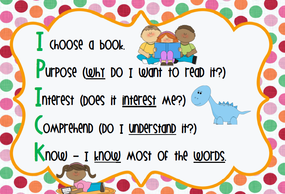
| Daily 5 begins with training students how to choose good-fit books. These are books that students can read independently (not too easy or too hard), and books they find interesting. Having a large classroom library with texts of varied levels in different genres allows students to choose good-fit books. This works well in a UDL classroom because all students are able to access texts to read in the classroom. Accessibility is also enhanced because students are frequently given opportunities to listen to stories (on mp3 players, or on the computer). |
- Read to self
- Listen to reading
- Read to someone
- Word work
- Work on writing
Each round of Daily 5 begins with a mini-lesson on a particular area (e.g. vowel sounds, blends, suffixes, parts of speech, etc). Short, frequent lessons works well in a UDL classroom because it promotes engagement and provides multiple means of representation (one of UDL's guiding principles). It is recommended to vary the methods of delivering mini-lessons to promote accessibility and engagement (e.g. targeting multiple intelligences, and using multiple media such as videos and SMART board games). I usually begin with a five minute mini-lesson, followed by a 20-25 minute round of Daily 5.
Daily 5 also promotes collaboration and community among students, which is a guiding principle of UDL.
Students are given opportunities to work with partners during read to someone, or as part of a group during word work.
The CAFE Book outlines how to teach reading strategies as a part of whole-class instruction, and to individuals or small groups during reading conferences. There are four categories of reading strategies, which are presented on a bulletin board:
- Comprehension
- Accuracy
- Fluency
- Expand vocabulary
Strategies are explicitly taught and modeled, and then 'strategy cards' are placed on the CAFE bulletin board in the appropriate category. For example: back up and reread is a comprehension strategy, and using beginning and ending sounds is an accuracy strategy. Explicitly teaching and modeling reading strategies is a UDL practice it provides students with graduated levels of support for processing and practice, and it optimizes relevance to students. For example: teaching students beginning sounds such as str (string, stray, strict, etc) and ending sounds (-ing, -ed, -tion, etc.) while reading a story is more authentic than teaching blends and suffixes in isolation, because it helps students understand why it is necessary to learn them.
Every student has a post-it with their name on it on the CAFE board. During a reading conference, based on self-reflection and feedback, students place their post-it in the category they need to work on. For example, after reading with a student, we may decide that they need to work on pausing for periods and commas, which is a fluency strategy, so the student would move their post-it to the fluency portion of the board and the teacher would model how to read punctuation. Involving students in goal-setting is a UDL practice, and it also helps enhance student motivation and engagement because students know what goal they are working on, why they need to work on it, and what steps they need to take to meet the goal. After students are given some time to practice working on 'their' strategy, they would meet with the teacher in a follow-up conference to monitor their progress, and if the goal is met, celebrate their success!
If you are already doing Daily 5 and CAFE, then it's possible that you're already doing UDL. If you're not familiar with these books by 'the Sisters', I'd highly recommend checking them out. They're not only easy to implement and enjoyable for students, both books are also an enjoyable read.




